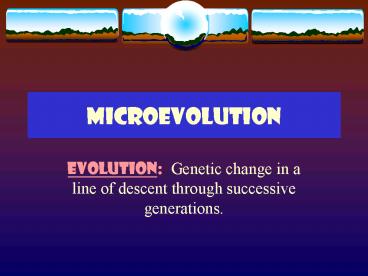Microevolution - PowerPoint PPT Presentation
1 / 24
Title: Microevolution
1
Microevolution
- Evolution Genetic change in a line of descent
through successive generations.
2
Early Beliefs
- Ancient Greeks gods determined human fate
- School of Hippocrates first attempts to find
natural explanations for observable events. - In nature, all things are alike in this, in
that they can be traced to preceding causes. - Aristotle originally believed that each org was
distinct from rest later, saw nature as a
continuum of organization. -- Chain of Being
3
New Discoveries
- World is MUCH bigger than originally thought, so
discovery of orgs was overwhelming when tried to
place all in Chain. - Biogeography emerged study of world
distribution of orgs (raised many more questions) - Comparative morphology raises questions about
similarities and differences in body plans of
major groups embryological similarity (bat
wing, human arm, whale flipper) and vestigial
parts (pelvic girdle in snakes) - Geologists began mapping layers of rocks and
found similar layers around the world also found
fossils that raised many more questions about
sequences and similarities to existing species.
4
New Theories
- Georges Cuvier anatomist saw abrupt changes in
fossil record as corresponding to sedimentary
discontinuities evidence of changing
populations? - These ideas led to his theory catastrophism.
Was one time of creation that populated the world
with all species. Global catastrophes destroyed
many of these orgs. What survived, repopulated. - Jean Lamarck Inheritance of acquired
characteristics environmental pressures and
internal needs bring about permanent changes in
body form and functioning and offspring inherit
these changes. (page 376) Ex. Giraffe neck
increases in length due to need to feed.
5
Georges Cuvier
6
Jean Baptiste Lamarck
7
Figure 22.18 Charles Darwin in 1859, the year
The Origin of Species was published
8
(No Transcript)
9
Charles Darwin
- Loved outdoors, poor student, studied medicine
then theology. HATED schoolwork, but fan of
natural history. - One of his professors at Cambridge, John Henslow,
recommended Darwin for position as naturalist
aboard the H.M.S. Beagle 5 year voyage.
(1831-1836)
10
- On trip, read Charles Lyells Principles of
Geology -- subtle processes of change were more
important than catastrophies. Idea of gradual,
uniformly repetitive change became Theory of
Uniformity. This challenged thoughts on age of
earth instead of 6000 yrs, would have taken
millions of years. - Darwin began to focus on not only the time
factor, but more importantly on HOW did species
evolve in diverse ways.
11
Figure 22.x3 Charles Lyell
12
Figure 22.5 The Voyage of HMS Beagle
13
Darwins voyage and writings
- Spent very little time in the Galapagos Islands,
but was intrigued by the diversity in such a
small area. - Collected thousands of specimens, noted where and
how collected, and started comparisons aboard
ship (while suffered from seasickness). - When returned to England in 1836, talked with
other naturalists about evidence that life
evolves.
14
(No Transcript)
15
- Essay by Thomas Malthus
- a clergyman and economist
- correlated population size with famine,
disease, and war. Humans run out of resources
because reproduce too much and must compete for
their needs. - Populations grow, and struggle for survival
ensues war, famine, starvation, sickness. - ultimate result COMPETITION.
16
- Combining all of this with his own notes, came up
with a set of premises (see page 386 in textbook) - Nervous about publishing his controversial
theory, kept reviewing his ideas and searching
for flaws. - Not willing to publish until received letter from
Alfred Wallace who had reached same conclusions.
Thus, pressured to publish his findings first,
Darwin relented. - On the Origin of Species, 1859, detailed
Darwins evidence in support of evolution.
17
Figure 22.x5 Alfred Wallace
18
(No Transcript)
19
Figure 22.6 Galápagos finches
20
Descent with modification
Descent with modification
21
Figure 22.1 The historical context of Darwins
life and ideas
22
Darwin challenged
- Biggest issues against Darwin were lack of
missing links transitional forms (Ex.
Archaeopteryx) and specific explanation of
gradual evolution by natural selection. - Darwin did not have a concrete explanation for
HOW changes could be passed on to offspring
this took Gregor Mendels work with genetics and
the garden pea, and then the ideas had to be tied
together.
23
(Paleon.) A fossil bird, of the Jurassic period,
remarkable for having a long tapering tail of
many vertebrae with feathers along each side,
and jaws armed with teeth, with other reptilian
characteristics. 1913 Webster
24
(No Transcript)































